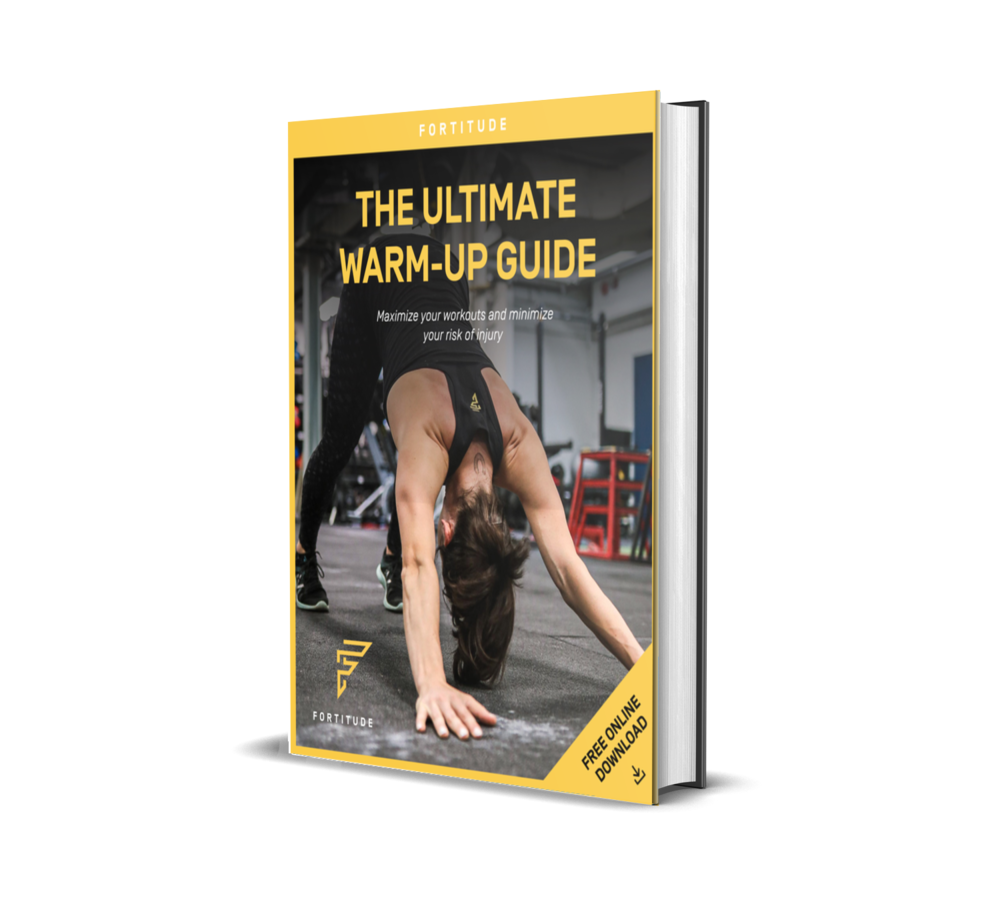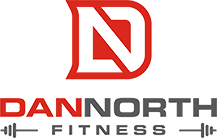
How to Engage Your Glutes During Hip Thrusts
Aside from squats, hip thrusts are up there on the list of most effective exercises you can perform to really get your glutes going. When performed correctly, the amount of concentration you get in those big ol’ butt muscles is amazing.
In addition to it’s aesthetic benefits (which is why it’s such a fan favourite among most of the women in the weight room), the hip thrust has a HUGE carryover to your overall health, performance, and strength in the other main lifts (squat, bench, deadlift).
The problem? There’s two actually:
- Not enough people are doing them
- Most people are doing them wrong (I’ll explain how in a second)
HOW TO HIP THRUST
First, for those who don’t know what the hip thrust is, it looks like this:
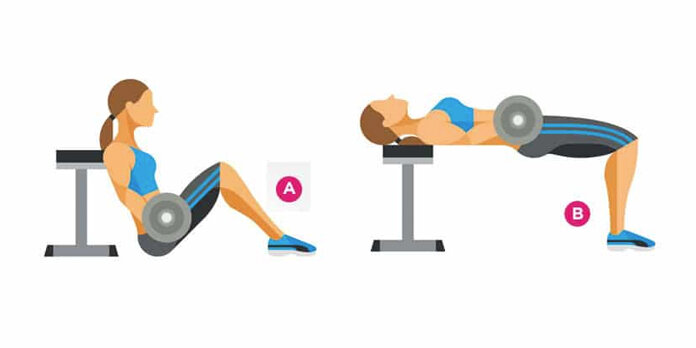
- Shoulders are placed against bench
- Feet are about shoulder-width apart on the floor (similar to your squat stance)
- Bar or dumbbell is placed on your pelvis (you can also do it without weights)
- Bring your hips up and squeeze your butt
- Bring your hips down and repeat
If you’ve never done them before, they can feel a little awkward. One of my clients calls them “air fuckers”.
You get the idea. Anyway…
Most exercises that sound simple on paper, aren’t.
Yes, the idea of the hip thrust is very straightforward, but in order to perform it optimally, there needs to be some attention to detail.
When attention to detail is lost, mistakes can be found.
3 COMMON HIP THRUST MISTAKES
1. Narrow Stance
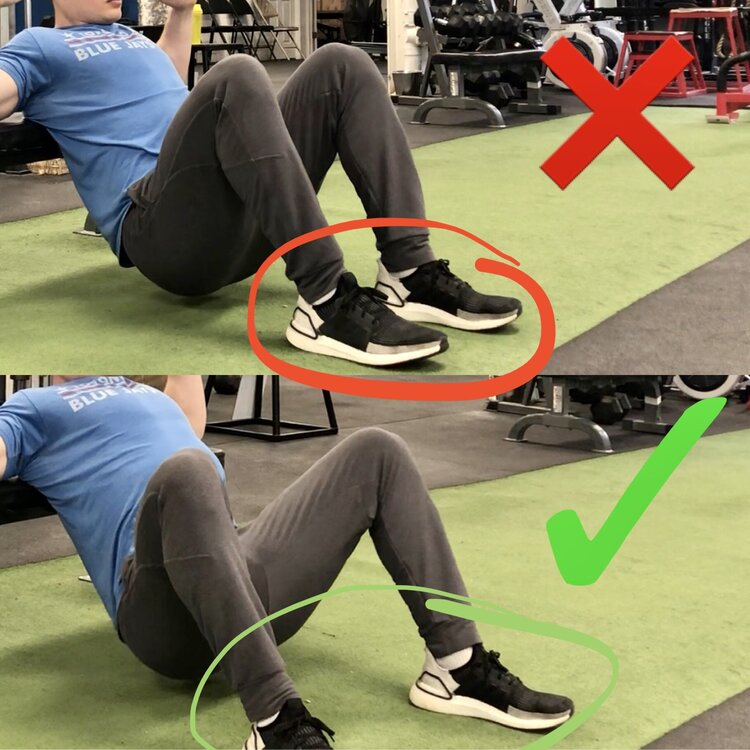
You want your feet to be set-up like your squat stance. A common mistake is to place your feet too close together and/or too close to the body. If you’re looking to engage your quads more, a narrower stance might help. But if you’re looking to really hammer home your glutes, having your feet slightly wider than shoulder-width apart is a good starting point.
Also, you don’t want your feet so close to your butt that your heels raise off the floor as you push your hips up. Ideally, you want a vertical shin angle when you bring your hips up with your feet flat on the ground.

Drive through the floor with most of the pressure on your heels. Do not let the front of your foot raise off the floor, though. Some people think that since they should be driving through their heels, then it’s ok if the front of their foot leaves the ground. Even though most of the pressure should be on your heels, you still want to keep your feet flat on the ground and ‘rooted’ to the floor.
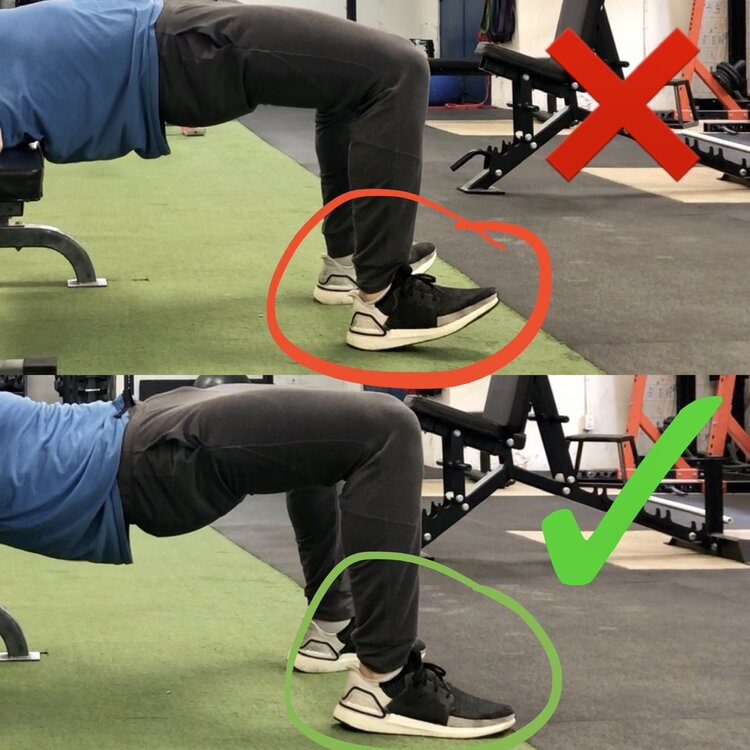
2. Rib Flare
99% of people who perform hip thrusts do this mistake.
Most people will push their hips up excessively, causing hyperextension in the lower back. This turns the hip thrust from a glute exercise, to a lower-back-dominant movement. That’s not good.
Instead, try keeping your ribs down as you extend your hips up. This maintains constant tension in the glutes and eliminates any unwanted stress in your lower back.
This one little correction will make a world of difference for you, I promise.
So if you want to really feel it in your butt, keep your ribs down as you extend your hips up (as shown in the pic below).
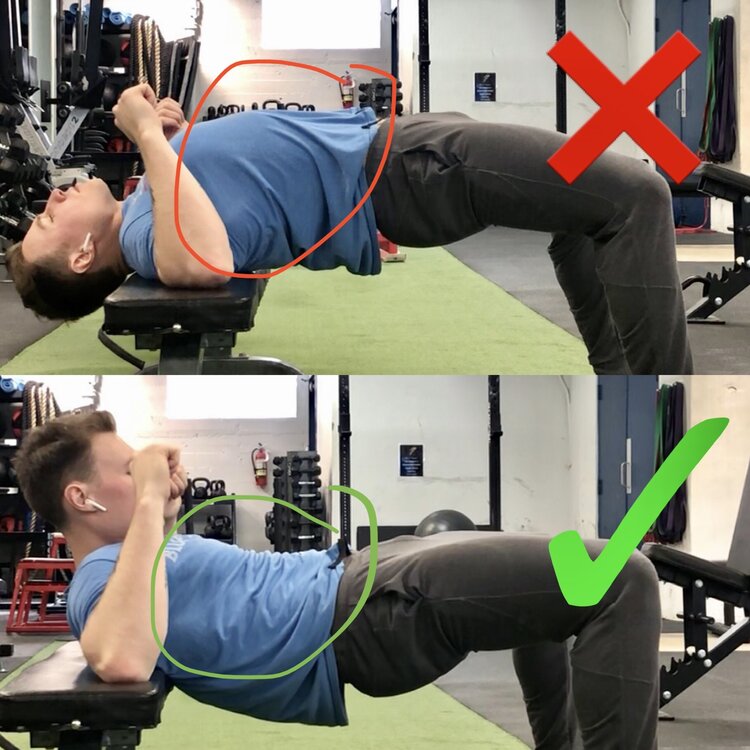
This small tweak is immensely effective for two reasons:
i) It maintains tension in the glutes while eliminating lower back stress
ii) It engages your core throughout the entire set
Boom. Win-win.
CLICK THE IMAGE BELOW TO DOWNLOAD YOUR FREE WARM-UP GUIDE
3. Neck Cranking
You’ll typically see people cranking their necks back and forth as they perform hip thrusts and wonder why their necks ache whenever they do them. Instead of pushing your head back past the other side of the bench, try this…
Pick a spot straight ahead and stare at it throughout the set. You want your chin to be slightly tucked with your head in alignment with your upper back (as if you were standing up naturally). As you do your set, your head/neck stays in a consistent “neutral” position throughout (as shown in the pic below).

A neat little trick…
Keep your tongue on the roof of your mouth the whole set. This helps activate some of the small, but very useful, stabilizer muscles of the neck.
So, if you find your neck hurts while doing hip thrusts, this small tweak should help.
HOW TO GRIP THE BAR
Personally, I prefer just placing my palms on the barbell as opposed to gripping the bar with my thumbs wrapped around it.
Why? You’ll typically tend to pull up with the arms more by gripping the bar, instead of pushing the weight up entirely with your glutes.
But the choice is up to you!!!
If you prefer gripping the bar with your thumbs wrapped around because you feel more confident balancing the bar that way, do it. Just try not to pull with your arms and focus on driving the weight up with your glutes as much as possible.

Bottom image shows gripping the barbell with thumbs wrapped around.
Both are great. Do what feels most comfortable for you.
3 BONUS BOOTY-BUILDING TRICKS DURING HIP THRUSTS
There are a few little “tricks” you can use to feel your ass muscles working even more when performing hip thrusts.
1. Pre-Exhaust Isolation Exercises
All pre-exhaust means is you “exhaust” the muscle you’re trying to target with some light isolation exercises before performing the main lift (in this case, the hip thrust). This is a great strategy to use in your workouts if you’re having trouble engaging certain muscles during big compound exercises.
How to do it…
Pick a glute isolation exercise you love where you can really feel your butt working (something simple like a cable kickback is perfect).
Use light weight and perform 20-30 reps for 2-3 sets to get the blood concentrated to the glutes.
After you do this, move on to hip thrusts and your glutes will already be “primed” and ready to go! You should feel them working way more during your sets since you’ve already established that “mind-muscle connection” with your pre-exhaust sets.
2. Isometric Holds
Your muscles can contract three ways:
i) Concentrically: When the muscle shortens under load (ex. upward motion of a biceps curl)
ii) Eccentrically: When the muscle lengthens under load (ex. downward motion of a biceps curl)
iii) Isometrically: When the muscle does not change in length under load (ex. holding or pausing a position)
Next time you do hip thrusts, try holding the top part of the movement (when your hips are extended up) and squeeze the fuck outta your butt for 3-5 sec each rep. It works, trust me!
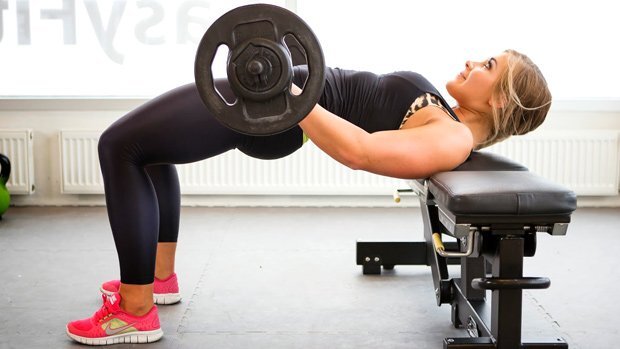
Adding isometric holds to your hip thrusts at the top part of the movement will really help you feel your glutes working because it will give you an opportunity to practice proper form and not just steamroll your way through your set.
Also…building muscle is all about attacking and challenging your muscles in new ways. I’m willing to bet most people reading this can’t remember the last time they’ve added pauses to their hip thrusts. So give it a shot!
3. Hip Circle
The Hip Circle (created by Mark Bell) is a truly amazing piece of equipment. If there’s one thing I almost always recommend to all my clients, it’s to get one of these. Throwing the Hip Circle around your knees really fires up the glutes because of the force it applies inward. It pushes your knees inward towards each other, which forces you to push out and externally rotate the hips, causing automatic tension in the glutes.
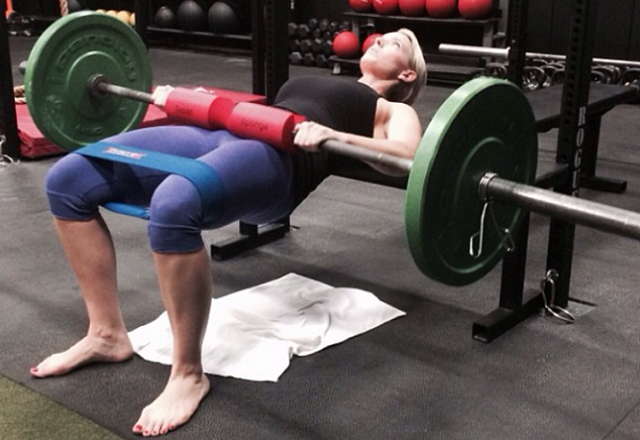
You can get one here (I am not affiliated with this company at all and I do not get any money for this…I just love the product): Hip Circle by Sling Shot
You can use the Hip Circle with plenty of other exercises as well, not just hip thrusts. You can wear it during squats, lunges, deadlifts, bench…any movement where you want to increase glute tension.
KEY POINTS
- Keep your feet rooted to the floor and drive through the heels.
- Keep your ribs down as you extend your hips up.
- Force your knees out (don’t let them cave in towards each other at any point throughout your set).
- Pre-exhaust isolation exercises with light weight for 20-30 reps is a great way to establish mind-muscle connection and get your glutes engaged before hip thrusts.
- Isometric holds help practice proper form and cause more time under tension in the glutes when holding the top portion of the hip thrust.
- Adding a Hip Circle around your knees during hip thrusts and other lower body compound movements is one of the best ways to add more tension in the glutes.
If you have any questions or comments about this post…please shoot me a message down below 🙂


